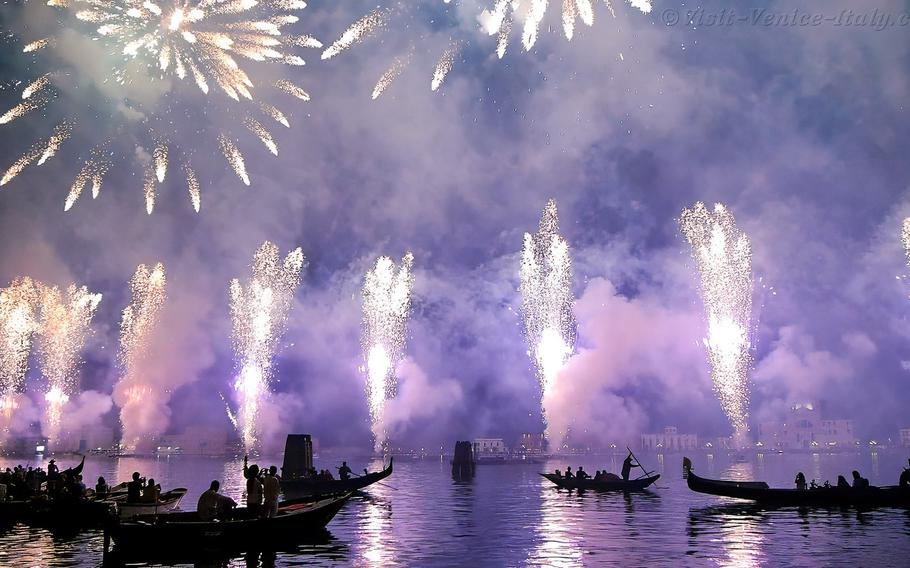
The Festa del Redentore, or Feast of the Redeemer, harks back to the year 1577. (visit-venice-italy.com)
Europe’s countless festivals, historical re-enactments, anniversary celebrations and the like represent an opportunity for locals and tourists alike to come together in relaxed settings. While the costumes and traditions on display at such affairs are bound to delight even those without a great deal of background knowledge about the original event that’s being commemorated, it can be rewarding to delve a bit into the history behind the proceedings that are still carried out in our present day and age. While the audacious acts of the heroes of these tales might not have played out exactly as depicted, historical backgrounds such as battles or the presence of influential figures is oftentimes more or less fact-based. Here are a few upcoming main events at which history can be the side dish.
Venice, Italy: The Festa del Redentore, or Feast of the Redeemer, harks back to the year 1577. For two years, a plague had ravaged the city, killing roughly a third of its inhabitants. The plague’s end was attributed to divine intervention, and in gratitude for easing the suffering, the Venetian Senate commissioned the building of a grand church, the Basilica del Redentore on Giudecca Island.
This year’s festivities running July 18-20 are set to play out as they do most years. Friday will see the opening of a temporary votive bridge connecting the basilica to the district known as Zattere. On Saturday, various musical performances will take place prior to the most anticipated event, a grand display of fireworks shot over Saint Mark’s Basin starting at 11:30 p.m. Venetians and their friends with access to watercraft turn out in force to happily while away the hours before with picnics and cooling beverages. Back on land, long tables are set up for al fresco dining on local specialties. Sunday’s activities include a gondola regatta and Mass in the basilica at 7 p.m. Online: tinyurl.com/ywaayb78
Dinkelsbühl, Germany: Each year in summer, the children of this idyllic Bavarian village are called to take part in a historical re-enactment known as the Kinderzeche. The action revolves around how the children of Dinkelsbühl, led by the daughter of the keeper of the watchtower, convinced the Swedish occupiers to spare their town from destruction during the Thirty Years’ War in 1632. Plays, parades, folk dancing and sword fighting figure into events held over a 10-day period. No less interesting is just how long the town has held festivities involving students: scholars trace the youngsters’ merriment back to the 17th century.
This year’s festival is set to play out July 18-27. Visitors can elect to watch the play on all fest days or parades on July 20, 21 and 27. Tickets to either event can be ordered online and cost from 7 euros up. A volksfest with all the usual attractions also takes place in town July 18-23. Online: kinderzeche.de
Ulm, Germany: “Schwörmontag,” or Oath Monday, is the day the Lord Mayor repeats a solemn promise to the citizens of the city: to work equally for all, serving rich and poor alike. The swearing of the first oath can be traced back to 1345, against the backdrop of a power struggle between the noble class and the guilds in what was then a Free Imperial City.
The tradition is set to repeat itself once again on July 21, when the mayor will appear on the balcony of the Schwörhaus and swear to uphold Ulm’s constitution. From about 11 a.m., an account of the social and political highlights of the past year will be delivered, followed by a prognosis of what’s anticipated in the coming year.
As in all years, this event without much of a fun factor will be followed by one that’s loved by all ages: the Nabada, a collective paddle/float/swim along the Danube River. Beginning around 4 p.m., dozens of boats belonging to clubs and other groups will take to the water. These boats, decked out to ridicule current culture and politics, are accompanied by non-official participants riding on whatever contraptions they can manage to keep afloat along a four-mile stretch of the river. As evening falls, revelers gather in the Friedrichsau Park and other parts of town, as concerts crown the summer day. Other elements of the celebrations stretching over the weekend include a serenade of lights, in which 20,000 red and yellow tea light candles are released into the river at the fall of twilight (July 19) and a fisherman’s joust and parade (July 20). Online: tinyurl.com/5evsh4j4
Bad Kissingen, Germany: This handsome spa town’s biggest annual bash is its Rakoczy Fest, held at the end of July each year. The festival recalls not so much a singular event but rather the long line of royals and rulers who were drawn to the town following the discovery of a spring with healing powers back in 1737. The who’s who list included Tsar Alexander II of Russia, the Bavarian kings Ludwig I and Ludwig II, Otto Prince von Bismarck and dozens more; costumed versions of these famous names are all but certain to turn up at the fest’s highlight event, the parade set for 2:30 p.m. on July 27. Horse-drawn carriages pulling yesteryear’s celebrities are accompanied by marching bands and flower-bedecked floats depicting the town’s landmarks. Other elements of the festival running July 25 - 27 include concerts, illuminated water fountains synced to music, a gala ball, closing fireworks and more. Online: rakoczy-fest-badkissingen.de